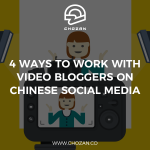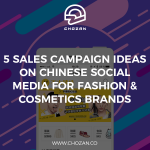Next month, Shanghai Fashion Week will be kicking off, not only offline, but online, as brands increasingly seek to engage a wider consumer audience in China. During the international fashion weeks over the last two months, luxury brands have also taken advantage of opportunities to use social media’s instant access and far-reaching influence to reach those who couldn’t attend or view the live shows. Battles between brands now happen not only on the runway, on TV, and in print, but also on social media, and things are becoming increasingly competitive.
Luxury brands have a smaller presence on Chinese social media than they do on social media outside of China. So how can Chinese social media be optimized during the international fashion weeks?
Here are eight great campaign strategies for fashion week:
WeChat: In-Depth Communication
WeChat, as China’s leading social media app, had 768 million daily active users at the end of 2016, half of whom spend at least 90 minutes per day on the platform. According to L2 Inc.’s Luxury China survey, there are 107 luxury brands in China and 92 percent of them have official WeChat accounts.
Here are some emerging trends during the fashion week for luxury brands on WeChat.
1. Well-targeted articles
This is the most common method brands adopt to connect with their customers on WeChat. WeChat users, especially brand fans and potential customers, follow the account to get fashion information and access to customer service. This approach guarantees highly visible content shared very directly to a targeted audience in real time.
During New York Fashion Week F/W 2017, Coach posted several articles on WeChat. An article entitled “Coach 2017 Fall” outlined the design concepts behind the new collection and the attached video featured the decorated show venue. Readers were also encouraged to click a virtual invitation letter to subscribe to the account to get the latest information about the “See Now, Buy Now” video model that allows viewers to purchase limited-edition products while watching the show.
Another article entitled “People in New York Love Themselves and Act Naturally” was an interview with five fashion bloggers about how they define the city, fashion trends, and the New York lifestyle.
The content matched the tastes of a Chinese audience because four of the bloggers were Chinese. Each article posted during fashion week had more than 100,000 readers and hundreds of likes.


↑ Content snapshots of Coach broadcast during 2017 New York Fashion Show.
2. Dedicated menu sections for key content
Runway updates are always in demand during fashion week. Previously, these could only be accessed through fashion KOL accounts or by going to the company’s official website and searching for them. This created a barrier between brands and consumers. With WeChat integration, brands are able to broadcast their runway news and photos directly to interested users through their official accounts.
For example, to better broadcast the 2017 fall/winter fashion weeks, Chloe created a dedicated section on its WeChat account called “Focus on the Scene”. It contains three parts to show various aspects of the fashion fests and give users updates, video broadcasts, collection previews, backstage highlights, guest snapshots, and more.
↑ Content snapshots of Chloe focus on scene section.
3. Mini-podcasts
During fashion weeks in 2016 and 2017, Burberry published exclusive mini-podcasts from famous Chinese celebrities Kris Wu and Dongyu Zhou on its official WeChat account.
They shared their insights during the fashion shows. The podcasts attracted a lot of attention from young fashion fans and are a new way for luxury brands to engage and bond with their audience.

↑ Snapshots of exclusive mini-podcasts by Chinese actors invited by Burberry.
Weibo: Mass Broadcasting
Compared to WeChat, Weibo is a much more open platform for information sharing, especially when it comes to raising public awareness in a short time. Although luxury brands currently take WeChat more seriously than Weibo, it’s still a major promotion platform that contributes to higher interaction rates.
Here are some popular and effective approaches to fashion week seen on Weibo.
4. Creating hashtags
Weibo’s hashtag topic function is often used to attract groups of users who have similar interests. Most luxury brands on Weibo have created their own hashtags, including those for each fashion week.
During New York Fashion Week, Coach set up a new Weibo topic—#Coachfall2017#—to broadcast runway shows and showcase its fall collection. The topic attracted more than 31 million users, created about 28,000 discussions, and led to over 600 fan gatherings. Coach posted 21 status updates for this topic, including high quality product images with official website links and a series of live videos that drew large audiences.
Hashtags increase in value and relevance when media, celebrities, and KOLs use them, and partnering with celebrities and KOLs to promote hashtags directs public awareness to the topic and the brand.
↑ A large quantity of Weibo users engaged in #coachfall2017# topic discussion and new collection products are shown under this topic.
5. Lucky draw campaigns
The public characteristics of Weibo allow brands to conduct lucky draw campaigns conveniently. With proper incentives, these campaigns help to achieve much wider exposure and engagement.
A month ago, Michael Kors launched a lucky draw campaign for New York Fashion Week. An 8-second video was posted showing Gul Nazar, a Chinese star, carrying a Michael Kors handbag in New York.
Viewers were asked to identify the bag shown in the video. Users who participated got a chance to win the handbag. Incentives can take various forms, but this form of Q&A campaign format is a great way to spread the word about a brand’s new products.
↑ Snapshots of Michael Kors lucky draw campaign on Weibo.
Live-Streaming: Catering to the Fan Economy
Live-streaming fashion shows has become a new trend for luxury brands. It’s up-to-the-minute, direct, and often uses original formats. They can include runway shows, backstage preparation, celebrity interviews, and more.
Young consumers in China have taken an increasingly important role in luxury consumption. They’re attracted to the products as well as the lifestyle and image projected by brands. Since young viewers make up the majority of live-stream audiences, this is a good direction for fashion houses.
6. Exclusive broadcasts
In January 2017, Dior launched its Haute Couture Spring/Summer 2017 fashion show and exclusively broadcast it on Tencent TV. During the live-stream, more than 6.6 million viewers watched. Half of them were from the post 90s and millennial generation.
↑ Snapshots of Exclusive broadcast of Dior Haute Couture Spring/Summer 2017 fashion show on Tencent TV.
7. Cooperation with celebrities and KOLs
During New York Fashion Week in September 2016, Coach invited Tang Yan and Li Yifeng, two famous Chinese celebrities to do a live stream of their visits to the Coach showroom. The two live-streams received over 3 million views and 7 million interactions in total. These impressive results show the power of live-streams to attract and involve an audience.
↑ Snapshots of live streaming of Coach Meipai official account cooperating with Tang Yan and Li Yifeng.
8. See now, buy now
Luxury brands have introduced a “see now, buy now” function to their broadcasts and live-streams. Customers can instantly buy online and in stores after the runway show.
During New York Fashion Week 2016 and 2017, Tommy Hilfiger used the see now, buy now approach in its Chinese market in conjunction with Tmall live-streaming. The brand invited three celebrities to live stream the fashion show. They did promos with the celebrities before the show to spread the word. During the show, the audience could purchase new products below the live-stream on Tmall, which instantly drove up online sales.
This was a revolutionary strategy that localized the brand and improved the purchasing experience for Chinese consumers.
↑ Snapshots of Tommy Hilfiger Tmall live-streaming during New York Fashion Week.
Conclusion
Based on the best practices listed above and upcoming trends, here are our fashion week recommendations for luxury brands on Chinese social media:
- Use WeChat as a presentation platform that allows your audience to search for fashion collection photos and information.
- Incorporate more celebrities/KOLs in your WeChat content, with exclusive interviews, Q&A sessions and lucky draws to increase exposure and consumer loyalty.
- Weibo is for a mass audience, broadcast oriented, and suited to fashion show previews, live streams, and backstage photos.
- Involve more fashion-related KOLs in your fashion week promos.
- Broadcasting fashion shows live to Chinese audiences on platforms like Yizhibo, Meipai, and Tencent can help luxury brands get more attention and enhance customers’ experience, especially when celebrities and KOLs are involved.
Disclaimer:
This article was originally published on Jing Daily, while ChoZan is the contributor.
How High-End Brands Leverage Chinese Social Media During Fashion Week
To get deeper insights into Chinese social media marketing and utilizing it to serve your business, join ChoZan, a training and resources platform for Chinese social media marketers.
Please follow our official WeChat account to get more updates about the latest news, feature updates and case studies.

Share this article on your favourite social media














